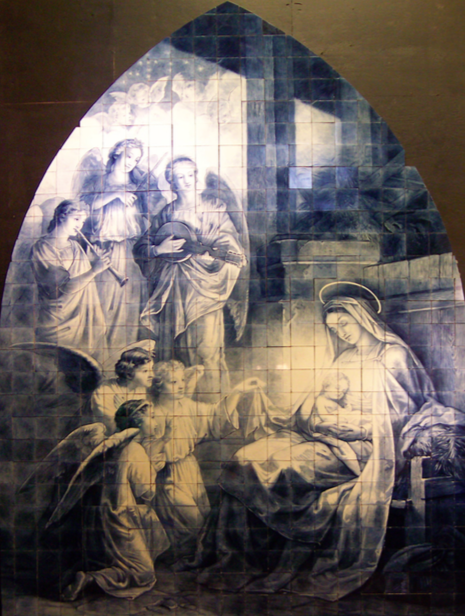Adoration of the Madonna & Child by Leonardus Johannes Senf

In 1897, All Angels Church on 80th Street in New York City commissioned the largest Delft tile painting in the world. The 500-tile work was hand-painted by Leonardus Senf, designed by Adolf Le Comte, and manufactured in Delft Joost Thooft. The work combines 400-years of technical virtuosity and the confidence of an academically-trained artist.
From the sixteenth century, the city of Delft has been synonymous with blue- and-white earthenware. Delftware, as it came to be known, adapted designs and shapes from imported Chinese and Japanese porcelains to European vessels. By the mid-seventeenth century, Delftware was an art form of its own; a staple of European Royal collections.
In 1850, Holland was surpassed by England as a major exporter of pottery. The technical advances in manufacturing and printing of the nineteenth-century replaced traditional craftsmanship. In 1876, Joost Thooft took control of the defunct factory De Porceleyne Fles with the ambition to return Delftware to world prominence. Thooft hired, Adolf Le Comte, a young designer, and the painter Leonardus Senf. Their interpretations of Old Master paintings were hand-painted on tin-glazed earthenware works and made with traditional materials and techniques. Within ten years, their ambitions were recognized with Royal patronage and awards at international exhibitions in Amsterdam, Paris, Chicago, and New York.

Much like working in frescoes, tin-glazed tiles could only retain pigment for limited periods–a giornatta–before surfaces dried. Tiles had the added uncertainty of surviving the firing and glazing processes, which resulted in multiple breakages. Most pieces by Senf were single plates. Two ambitious works are found in the Rijksmuseum and Fitzwilliam Museum and are made of no more than ten tiles each. By comparison, the skill needed to ensure continuity of tone throughout for the 500-tile Adoration of the Virgin and Child would have been staggeringly expensive and time consuming.

Senf had the unique ability to convincingly portray the work of Old Masters despite the unforgiving demands of the medium, which often required sections to be painted multiple times while communicating a sense of spontaneity and uniformity. In this monumental work, Senf paints eight full-sized figures. It retains the compositional genius of Giovanni Battista Tiepolo (1696-1770), leading the eye from cherubim, to angels serenading the Virgin who holds the Christ child. The cobalt blue used by Senf was temperamental, often becoming darker or lighter during the firing process. He had virtuosic ability to communicate sharp detail that draws the eye to key moments in the narrative and diffuse others–even while depicting materials as diverse as wood, hay, skin, clouds, clothing, and stone.
MUSEUMS
Rijksmuseum, Amsterdam Victoria & Albert Museum, London Noordwijk Museum, Noordwijk Metropolitan Museum, New York Getty Museum, Los Angeles
REFERENCES
De Jonge, Caroline Henriette. Dutch Tiles (Praeger, 1971)
Jervis, William Percival. The Encyclopedia of Ceramics (Canal Street, 1902) Hannover, Emil and Bernard Rackham. Pottery & Porcelain: A handbook for collectors (Charles Scribner’s Sons, 1925)
Lahor, Jean. Art Nouveau (Parkstone Press, 2007)
Stiles, Helen, E. Pottery of the Europeans (Dutton, 1940)



